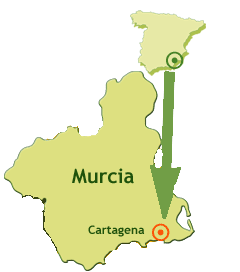|
|

|
|
Cartagena
Cartagena lies on the south-east coast of Spain, in the Region of Murcia. With a population of 200,000 inhabitants, Cartagena is the second largest city in the Region of Murcia. The city is one of the main ports on the Mediterranean sea. Its climate is Mediterranean, with little rainfall, hot summers and mild winters. Temperatures range between 12° in January and 30° in July.

Cartagena was founded by general Asdrubal, from Carthage, about 227 BC. However, the Carthaginian presence did not last long since the city was soon conquered by the Romans. During the 18th century, the city became the headquarters of the Maritime Department of the Mediterranean. Since then, Cartagena has gone several periods of crisis and prosperity to become the center we know today, an industrial, commercial and tourist city, and seat of the Regional Parliament of Murcia.
Cartagena has a valuable historical and cultural heritage that is reflected in the numerous museums, monuments and other tourist attractions throughout the city: the Archeological museum, the city Walls, the Roman theater and the city Hall, just to mention a few. Modern Cartagena also offers plenty of opportunities for recreation and entertainment: cinemas, theater, art galleries, music festivals, etc. Cartagena, like its university, is a welcoming city open to change and innovation.
|
|

